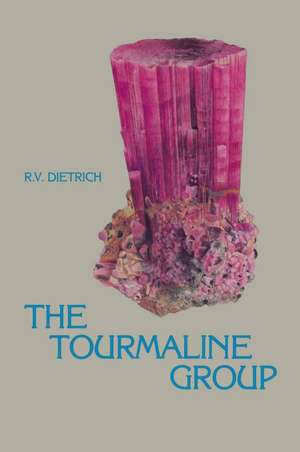The Tourmaline Group
Autor Richard Dietrichen Limba Engleză Paperback – 16 noi 2012
Preț: 389.11 lei
Nou
74.45€ • 77.95$ • 61.61£
Carte tipărită la comandă
Livrare economică 05-19 aprilie
Specificații
ISBN-10: 1468480871
Pagini: 328
Ilustrații: XVI, 302 p.
Dimensiuni: 152 x 229 x 22 mm
Greutate: 0.44 kg
Ediția:Softcover reprint of the original 1st ed. 1985
Editura: Springer Us
Colecția Springer
Locul publicării:New York, NY, United States
Public țintă
ResearchCuprins
1: Nomenclature.- 2: Symmetry and Morphological Crystallography.- Symmetry.- Morphological Crystallography.- 3: Crystal Structure.- Space Group.- Cell Dimensions.- Structure.- Information from Auxiliary Studies.- X-ray Diffraction Patterns.- 4: Chemistry and Alteration.- Formulae, Names, and Relations.- Analyses.- Solid Solution.- Alteration.- Dissociation.- Pseudomorphism.- 5: Inclusions and “Intergrowths”.- Tourmaline Inclusions in Other Minerals.- Mineral Inclusions in Tourmaline.- Fluid and Multiphase Inclusions in Tourmaline.- “Intergrowths” Involving Tourmaline.- 6: Color and Optical Properties.- Color.- Optical Properties.- 7: Physical Properties.- Density.- Hardness.- Elasticity.- Magnetic Properties.- Thermal Properties.- Radioactivity.- Electrical Properties.- 8: Synthesis.- Synthesis.- Stability.- Miscellany.- 9: Uses and Recovery.- Uses / 183 Recovery.- 10: Tourmaline as a Gemstone and in the Decorative Arts.- Lore Associated with Tourmaline as a Gemstone.- Color of Gem Tourmaline.- Cat’s-Eye Tourmalines.- Tourmalinated Quartz.- Names Applied.- Occurrences of Gem-Quality Tourmaline.- Fashioning.- Famous Stones.- Well-Known Specimens.- Distinguishing Tourmaline Gemstones.- Synthetics and Stimulants.- Miscellany.- 11: Occurrences and Geneses.- Igneous and Pyroclastic Rocks.- Soils, Sediments, and Sedimentary Rocks.- Diagenetic Rocks.- Metamorphic Rocks.- Migmatites.- Pegmatites.- Veins and Other Cavity Fillings.- Ore Deposits.- Additional Criteria for Diverse Origins.- Miscellaneous Occurrences.- Appendix A: “Other Forms” and Angles Between Relatively Common Crystal Faces.- Appendix B: Ideal Midpoint Analyses for Tourmalines of the Common Solid-Solution Series.- Appendix C: Localities That Have Yielded Noteworthy Tourmaline Specimens and/or Gem Materials.- About the Author.
Descriere
Tourmaline group minerals have graced the cabinets of mineral collectors and museums for untold generations. Their colors and color patterns, along with their diverse shapes and associations, have assured their role as exqui site showpieces. Their workability and durability have, in addition, made them favorites among connoisseurs of colored gemstones. Tourmalines, however, are much more than exquisite showpieces and beautiful gemstones. Their diverse crystal forms and unique structure, their variable chemical compositions, their intriguing physical properties, and their widespread occurrence in nearly all kinds of rocks have long attracted the attention of scientists from several disciplines. Furthermore, they have several potential uses in science and industry. From an historical standpoint: Tourmaline is possibly the "Lyngurium" -green at one end, light colored at the other-that Theophrastus (ca.315 B.C.) described in On Stones, the first known book about minerals. Tourma line is one of the minerals thought to have been used as a "sunstone" navigation compass by Vikings during the eighth, ninth, and tenth centuries.
